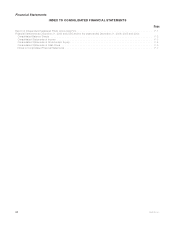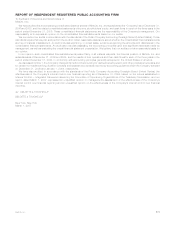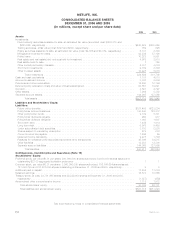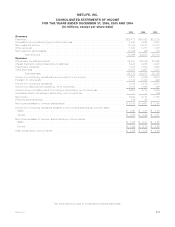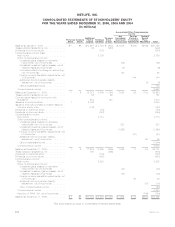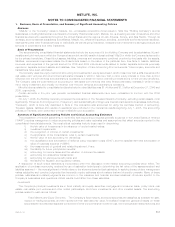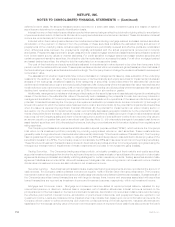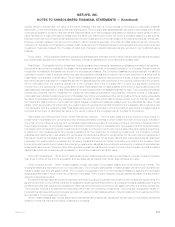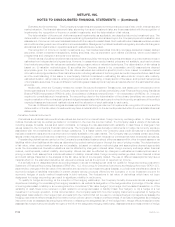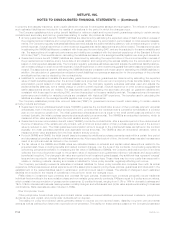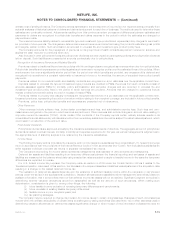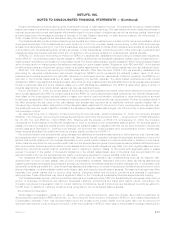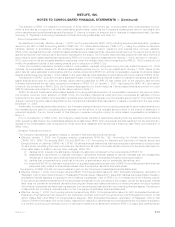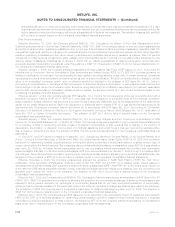MetLife 2006 Annual Report Download - page 93
Download and view the complete annual report
Please find page 93 of the 2006 MetLife annual report below. You can navigate through the pages in the report by either clicking on the pages listed below, or by using the keyword search tool below to find specific information within the annual report.Estimates and Uncertainties. The Company’s investments are exposed to three primary sources of risk: credit, interest rate and
market valuation. The financial statement risks, stemming from such investment risks, are those associated with the recognition of
impairments, the recognition of income on certain investments, and the determination of fair values.
The determination of the amount of allowances and impairments, as applicable, are described above by investment type. The
determination of such allowances and impairments is highly subjectiveandisbasedupontheCompany’speriodicevaluationand
assessment of known and inherent risks associated with the respective asset class. Such evaluations and assessments are revised
as conditions change and new information becomes available. Management updates it evaluations regularly and reflects changes in
allowances and impairments in operations as such evaluations are revised.
The recognition of income on certain investments (e.g. loan-backed securities including mortgage-backed and asset-backed
securities, certain investment transactions, trading securities, etc.) is dependent upon market conditions, which could result in
prepayments and changes in amounts to be earned.
The fair values of publicly held fixed maturity securities and publicly held equity securities are based on quoted market prices or
estimates from independent pricing services. However, in cases where quoted market prices are not available, such as for private
fixed maturity securities, fair values are estimated using present value or valuation techniques. The determination of fair values is
based on: (i) valuation methodologies; (ii) securities the Company deems to be comparable; and (iii) assumptions deemed
appropriate given the circumstances. The fair value estimates are made at a specific point in time, based on available market
information and judgments about financial instruments, including estimates of the timing and amounts of expected future cash flows
and the credit standing of the issuer or counterparty. Factors considered in estimating fair value include: coupon rate, maturity,
estimated duration, call provisions, sinking fund requirements, credit rating, industry sector of the issuer, and quoted market prices
of comparable securities. The use of different methodologies and assumptions may have a material effect on the estimated fair value
amounts.
Additionally, when the Company enters into certain Structured Investment Transactions, real estate joint ventures and other
limited partnerships for which the Company may be deemed to be the primary beneficiary under Financial Accounting Standards
Board (“FASB”) Interpretation (“FIN”) No. 46(r), Consolidation of Variable Interest Entities — An Interpretation of ARB No. 51,itmaybe
required to consolidate such investments. The accounting rules for the determination of the primary beneficiary are complex and
require evaluation of the contractual rights and obligations associated with each party involved in the entity, an estimate of the entity’s
expected losses and expected residual returns and the allocation of such estimates to each party.
The use of different methodologies and assumptions as to the timing and amount of impairments, recognition of income and the
determination of the fair value of investments may have a material effect on the amounts presented within the consolidated financial
statements.
Derivative Financial Instruments
Derivatives are financial instruments whose values are derived from interest rates, foreign currency exchange rates, or other financial
indices. Derivatives may be exchange-traded or contracted in the over-the-counter market. The Company uses a variety of derivatives,
including swaps, forwards, futures and option contracts, to manage the risk associated with variability in cash flows or changes in fair
values related to the Company’s financial instruments. The Company also uses derivative instruments to hedge its currency exposure
associated with net investments in certain foreign operations. To a lesser extent, the Company uses credit derivatives to synthetically
replicate investment risks and returns which are not readily available in the cash market. The Company also purchases certain securities,
issues certain insurance policies and investment contracts and engages in certain reinsurance contracts that have embedded derivatives.
Freestanding derivatives are carried on the Company’s consolidated balance sheet either as assets within other invested assets or as
liabilities within other liabilities at fair value as determined by quoted market prices or through the use of pricing models. The determination
of fair value, when quoted market values are not available, is based on valuation methodologies and assumptions deemed appropriate
under the circumstances. Derivative valuations can be affected by changes in interest rates, foreign currency exchange rates, financial
indices, credit spreads, market volatility, and liquidity. Values can also be affected by changes in estimates and assumptions used in
pricing models. Such assumptions include estimates of volatility, interest rates, foreign currency exchange rates, other financial indices
and credit ratings. Essential to the analysis of the fair value is risk of counterparty default. The use of different assumptions may have a
material effect on the estimated derivative fair value amounts as well as the amount of reported net income.
If a derivative is not designated as an accounting hedge or its use in managing risk does not qualify for hedge accounting pursuant to
Statement of Financial Accounting Standards (“SFAS”) No. 133, Accounting for Derivative Instruments and Hedging Activities (“SFAS 133”),
asamended,changesinthefairvalueofthederivativearereportedinnet investment gains (losses), in policyholder benefits and claims for
economic hedges of liabilities embedded in certain variable annuity products offered by the Company or in net investment income for
economic hedges of equity method investments in joint ventures. The fluctuations in fair value of derivatives which have not been
designated for hedge accounting can result in significant volatility in net income.
To qualify for hedge accounting, at the inception of the hedging relationship, the Company formally documents its risk management
objective and strategy for undertaking the hedging transaction, as well as its designation of the hedge as either (i) a hedge of the fair value
of a recognized asset or liability or an unrecognized firm commitment (“fair value hedge”); (ii) a hedge of a forecasted transaction or of the
variability of cash flows to be received or paid related to a recognized asset or liability (“cash flow hedge”); or (iii) a hedge of a net
investment in a foreign operation. In this documentation, the Company sets forth how the hedging instrument is expected to hedge the
designated risks related to the hedged item and sets forth the method that will be used to retrospectively and prospectively assess the
hedging instrument’s effectiveness and the method which will be used to measure ineffectiveness. A derivative designated as a hedging
instrument must be assessed as being highly effective in offsetting the designated risk of the hedged item. Hedge effectiveness is formally
assessed at inception and periodically throughout the life of the designated hedging relationship. Assessments and measurement of hedge
F-10 MetLife, Inc.
METLIFE, INC.
NOTES TO CONSOLIDATED FINANCIAL STATEMENTS — (Continued)


